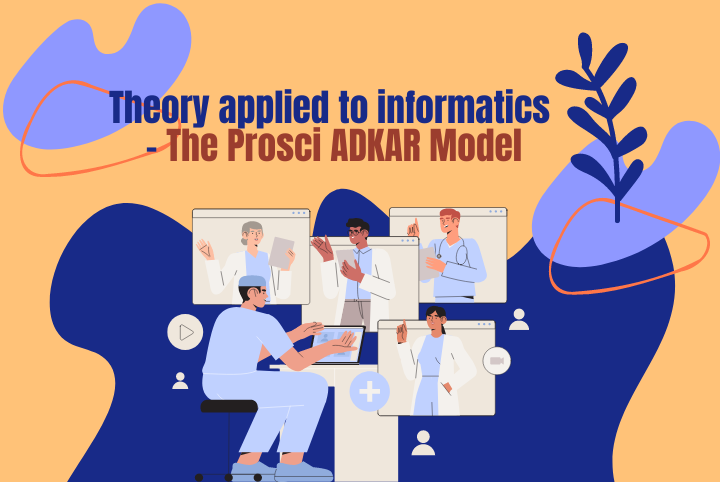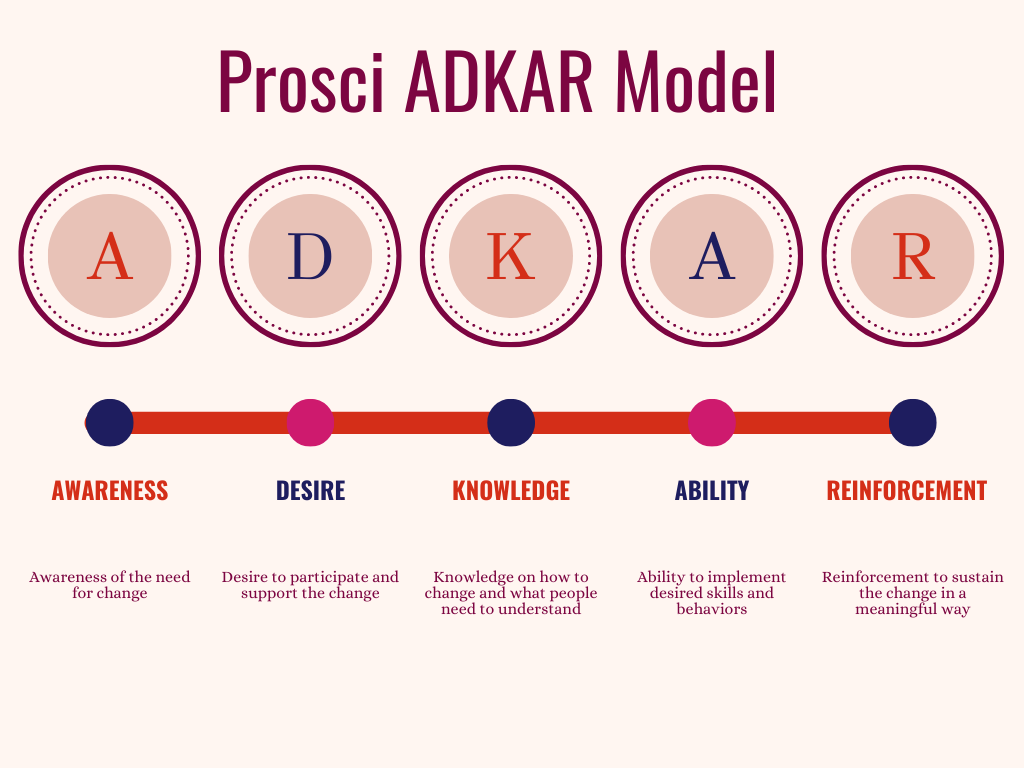by June Kaminski, RN MSN PhD(c)
Editor in Chief
Citation: Kaminski, J. (2022). Theory applied to informatics – The Prosci ADKAR Model. Editorial. Canadian Journal of Nursing Informatics, 17(2). https://cjni.net/journal/?p=10076

The Prosci ADKAR Model was released by Prosci, Inc. founder, Jeff Hiatt in 2006 to provide a guide for leaders to support individual change within organizations (Hiatt, 2006; Prosci Inc, n.d.). The focus of this model is on the individual person, since all successful change occurs at the personal level where people involved in the change move through stages of acceptance and action. “The lens of the ADKAR Model reveals both key concepts that influence successful change and actionable insights for implementing these concepts” (Prosci, Inc. n.d., p. 3). “The ADKAR Model of Change Management is an outcome-oriented change management method that aims to limit resistance to organizational change” (Malhotra, 2019, p. 1).
Hiatt (2006) proposed that the five stages of change are distinct, cumulative and sequential, each an important step for fully embracing change within organizations. These stages include: Awareness, Desire, Knowledge, Ability and Reinforcement. ADKAR is an acronym for these five stages and the “five-step process incorporates individual commitment at multiple levels and in multiple ways” (Jones-Schenk, 2019, p. 148).
Applying the model early in a project helps leaders to identify gaps, barriers, and best steps to take to help individuals adapt and move through the change process as a project or major system change is designed, planned, and implemented. This model emphasizes the personal, since when projects fail, it is usually because of a disconnect with the people involved with the change. If the model is applied after a project has been initiated, it can provide insight into where the project is slowing down, and identify what leaders need to focus on to promote acceptance and involvement across the organization. It also reinforces that change successfully occurs, one person at a time.
“Projects commonly fail when there are problems with the people side of change. This is true even with a well-designed project plan. The five outcomes organizations must achieve for success with the people side of change also comprise the elements of the Prosci ADKAR Model:
• Awareness of the need for change
• Desire to participate and support the change
• Knowledge on how to change
• Ability to implement desired skills and behaviors
• Reinforcement to sustain the change” (Prosci, Inc. n.d., p. 7).
Awareness
An important aspect of initiating change is people’s awareness of why the change is important, what the plan for the change looks like, how they can be involved and what the result will look like. This initial step is imperative to reduce resistance to the change. At this stage, it is important to make a compelling case for the change and begin to involve people at the very beginning of the project. An organizational culture that uses communication to keep people aware and up to date with the change rationale and processes can work wonders in helping them navigate this stage of the change process (Jones-Schenk, 2019).
Awareness is the first step in reducing resistance to change. According to Hiatt, the “top five reasons for resistance to change include (a) loss of power, responsibility, or resources; (b) overburdened with current responsibilities and workload; (c) lack of awareness of the need for change; (d) lack of skills or preparation to manage the change; and (e) fear or uncertainty about changes being made” (2006, p. 90).
Desire
This stage of the model is considered the most challenging since desire emerges from a person’s own motivations and acceptance of the proposed change. Leaders can provide rationale, motivators and incentives that can influence desire, but ultimately, this stage must be achieved internally by the individual themselves. Proactive engagement and involvement are critical to help people move through this stage of the change process. “You want to make a compelling case for adopting change management and build on the Awareness created earlier” (Creasey, n.d., p. 1). It is helpful if change leaders identify the possible factors and forces that could either support or deter the desire to be part of or even embrace the proposed change (Ebert, n.d.).
Knowledge
According to the ADKAR model, it is only after Awareness and Desire have developed that leaders should focus on building Knowledge through training, education, and discussion (Prosci, Inc. n.d.; Creasey, n.d.). Knowledge includes understanding the rationale for the change, knowing how to change, as well as what people need to learn and understand in order to successfully function within the changed environment. An example is helping people to learn how to use a new software program. “Only after building awareness and desire should we begin providing detailed knowledge of how to use the new software. Unfortunately, organizations commonly see a change coming and the first step they take is to send employees to training. The result of this approach is that the training is not highly effective. Employees are not engaged in the detailed functionality of the software because they are not prepared to learn. They may not even know why they are there in the first place. To make the most of a training investment, it must come after initial awareness and desire building” (Prosci, Inc. n.d., p. 11).
Ability
The skills and behaviours required to implement a change successfully develop during the Ability stage of the ADKAR model. To succeed, it is important that time, resources, and leadership are invested to support people to develop these required skills and behaviours. To bridge the gap between knowledge and ability, training and other resources must address both of these ADKAR steps in an individualized way, since each person is unique and requires personalized support within a safe and supportive environment. For instance, when adopting new software, “to bridge the “knowledge-to-ability gap,” employees will benefit from hands-on coaching and practice using the software before go-live. This practice could take place in a formal training setting or by working through a simulated live environment. What matters is that the employees using the software have the opportunity to try it out, make mistakes, and ask questions in a safe environment. Often, employees simply need time to adopt the changes. The best thing we can do is give them time to practice” (Prosci, Inc. n.d., p. 12).
Reinforcement
The final stage of the ADKAR model addresses the actions and process used to reinforce and sustain change over the long-term. Although reinforcement is critical as the change is realized, it is also an important component of the entire change process. Acknowledging the procession through the steps and recognizing the effort people contribute to a change helps to build momentum and support people as they move from awareness to desire, and so on. Reinforcement is especially effective in sustaining change when it is meaningful to the people involved: this includes whether it is expressed through recognition, rewards, celebration, positive feedback, positive consequences, or through other means. The crux of this stage is to reinforce the new and prevent people from falling back into the old way things used to be done.
Application to Healthcare Changes and Informatics
The ADKAR model focuses on the people involved in organizational change, which fits well with healthcare change initiatives since the professionals who must enact the change are critical players in its success. Balluck et al., (2020) applied the ADKAR model to move from primary nursing to team nursing during the COVID pandemic and found “The Prosci ADKAR model provided leaders with the tools to better communicate, explain, and train care team members while implementing a change” (p. 543). Devane et al., (2021) used the model to guide a process evaluation of changes done to the delivery of mental health and substance use services during the pandemic. Glegg et al., (2019) applied the model to help lead personnel in the development of a “custom-designed Excel-based visual management tool. The tool’s purpose was to support program planning and evaluation by our resource support team within a paediatric health care setting” (p. 16).
Kachian et al., (2018) also used the model to shape a survey to examine the readiness of Iranian nurses to change to a new Kardex system. Lawrence and Frater (2017) used the model to guide a national initiative in Australia to “change from morphological manual testing for cervical cancer to automated molecular testing” (p. 31). Wong et al., (2019) described how the ADKAR model was used to guide the transition to a new hospital facility with a change in service delivery and how they started applying the model to the transition process two years ahead of the scheduled move date to give people time to adapt. “Including frontline staff in the decision-making process garnered increased engagement, buy-in, and ownership of the change process. Frontline staff members provided feedback that there was a high level of support from nurse leaders, who were visibly working alongside them during this transition. Nurse leaders continue to incorporate the change management principles into their daily routines to ensure the sustainability of the implemented changes” (p. 35). Pawl & Anderson (2017) described how the “ADKAR Change Management Model, one of many organizational change resources, was advantageous in consolidating two diverse nursing programs when two universities were mandated to become one” (p. 233).
The ADKAR model has been a useful tool to guide informatics and technology-related initiatives (Ali et al., 2021; Penchev, 2021; Shonhe & Grand, 2020; Todd, n.d.). Penchev (2021) outlined how the ADKAR model was used to frame changes undertaken by the European Network of Cybersecurity Centres and Competence Hub for Innovation and Operations (ECHO) Project. “The change management model ADKAR suggests a lifecycle for implementation of the change. It aligns the building blocks of the ADKAR with a transformation project lifecycle from planning to deployment of the change. Thus, explaining, planning and designing the change (Awareness and Desire); developing the tools for change (Knowledge and Ability) and finally, deploying new capabilities through Reinforcement” (Penchev, 2021, p. 94). Todd (n.d.) looked at the viability of the ADKAR model in supporting Artificial intelligence (AI) development and change within organizations and concluded it is “a strong and useful tool to facilitate change, to understand employees’ response to AI application, to support the transition periods, to create the proper environment and skills for achievement and stabilize the new working procedures combining humans and AI talents” (p. 2).
The ADKAR Model provides a well-rounded framework that can be applied to any organizational change including healthcare related ones. It addresses a critical component inherent in all change projects by focusing on the people. Helping people to overcome resistance, become motivated and engaged, and learn what they need to know and be able to do to work well with the change are all central aspects of effective change management.
References
Ali, M. A., Mahmood, A., Zafar, U., & Nazim, M. (2021). The Power of Adkar Change Model in Innovative Technology Acceptance under the Moderating Effect of Culture and Open Innovation. LogForum, 17(4), 485–502. https://doi-org.ezproxy.kpu.ca:2443/10.17270/J.LOG.2021.623
Balluck, J., Asturi, E., & Brockman, V. (2020). Use of the ADKAR® and CLARC ® Change Models to Navigate Staffing Model Changes During the COVID-19 Pandemic. Nurse Leader, 18(6), 539–546. https://doi-org.ezproxy.kpu.ca:2443/10.1016/j.mnl.2020.08.006
Creasey, T. (n.d.). Applying the ADKAR Model When Change Management is New. Prosci, Inc. https://www.prosci.com/blog/applying-the-adkar-model-when-change-management-is-new
Devane, C., Saulnier, L., & Latham, L. (2021). Coastal Mental Health and Substance Use Services’ COVID-19 Response: A Quality Improvement Initiative. Nursing Leadership (1910-622X), 34(3), 40–50. https://doi-org.ezproxy.kpu.ca:2443/10.12927/cjnl.2021.26594
Ebert, J. (n.d.). To Implement Technology Changes, Utilize ADKAR. Three Will. https://threewill.com/to-implement-technology-changes-utilize-adkar/
Glegg, S. M. N., Ryce, A., & Brownlee, K. (2019). A visual management tool for program planning, project management and evaluation in paediatric health care. Evaluation & Program Planning, 72, 16–23. https://doi-org.ezproxy.kpu.ca:2443/10.1016/j.evalprogplan.2018.09.005
Hiatt, J. (2006). ADKAR: A Model for Change in Business, Government and our Community. Prosci Research. https://store.prosci.com/adkar-a-model-for-change-en.html
Jones-Schenk, J. (2019). 70% failure rate: An imperative for better change management. The Journal of Continuing Education in Nursing, 50(4), 148–149. https://doi-org.ezproxy.kpu.ca:2443/10.3928/00220124-20190319-03
Kachian, A., Elyasi, S., & Haghani, H. (2018). ADKAR Model and Nurses’ Readiness for Change. Journal of Client Centered Nursing Care, 4(4), 203–212. https://doi-org.ezproxy.kpu.ca:2443/10.32598/jccnc.4.4.203
Lawrence, G. A., & Frater, T. G. (2017). Change management in healthcare: managing paradigmatic change in the Australian National Cervical Screening Programme. New Zealand Journal of Medical Laboratory Science, 71(2), 31–39.
Malhotra, G. (2019). ADKAR Model: What Is It and How to Use It? Whatfix. https://whatfix.com/blog/adkar-model-what-is-it-and-how-to-use-it/
Pawl, J. D., & Anderson, L. S. (2017). The use of change theory to facilitate the consolidation of two diverse Bachelors of Science in Nursing programs. Nursing Outlook, 65(2), 233–239. https://doi-org.ezproxy.kpu.ca:2443/10.1016/j.outlook.2016.10.004
Penchev, G. (2021). Planning and Implementing Change in Cyber Security Network Organisations. Information & Security, 50(1), 89–101. https://doi-org.ezproxy.kpu.ca:2443/10.11610/isij.5008
Prosci, Inc. (n.d.) The ADKAR Model Overview. https://www.prosci.com/methodology/adkar
Shonhe, L., & Grand, B. (2020). Implementation of electronic records management systems: Lessons learned from Tlokweng land Board-Botswana. Records Management Journal, 30(1), 43–62. https://doi-org.ezproxy.kpu.ca:2443/10.1108/RMJ-03-2019-0013
Todd, S. (n.d.). Artificial Intelligence is Changing Employee Experience and HR Management. Open Sourced Workplace. https://opensourcedworkplace.com/news/artificial-intelligence-is-changing-employee-experience-and-hr-management
Wong, Q. (2019). Leading change with ADKAR. Nursing Management, 50(4), 28–35. https://doi-org.ezproxy.kpu.ca:2443/10.1097/01.NUMA.0000554341.70508.75






